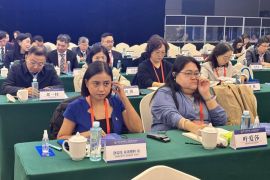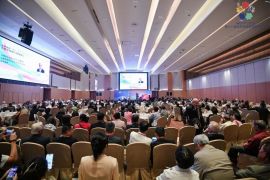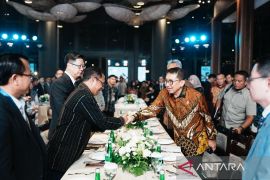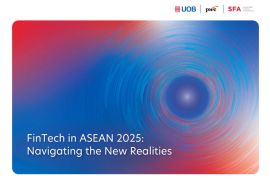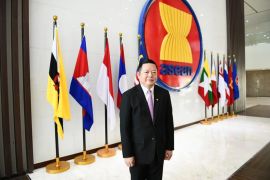The SCS disputes were again discussed by panelists at an international seminar organized by the Center for Asian Strategic Studies (CASS)-India in association with the Institute of ASEAN Studies and Global Affairs (INSPAG) UiTM, in Kuala Lumpur, on Monday, October 17, 2011.
ASEAN members Vietnam, the Philippines, Brunei and Malaysia, along with China and Taiwan, have made overlapping claims to parts of the SCS, an area believed to hold vast oil and gas reserves.
The current tensions in the SCS arose after the People`s Republic of China made its "U-shaped line" or "Nine dashed line" maritime sovereignty claim to almost the entire SCS where countries within and outside the region have always enjoyed freedom of navigation and the right to cooperate with one another to exploit the sea`s natural resources in accordance with international law.
Dr. Connie R. Bakrie of the University of Indonesia said in her paper at the seminar that the U-shaped line lay around an area in the middle of the SCS where any member of the international community has the right to exploit existing natural resources economically.
The line is drawn around a vast area of sea, adversely affecting the rights of nations that are entitled to exclusive economic zones (EEZs) and the international community.
"To justify such an extensive claim, Beijing would have to adduce the status of historic sovereignty and rights over maritime space," she said.
The claim had adversely affected international relations in the region, provoked acute legal entanglements, and ignited widespread criticism, and thus created a potential threat to peace, stability and development in the region.
The tensions between China, the Philippines and Vietnam reached their highest level in the first half of 2011 with the latter two ASEAN member countries giving strong reactions to Chinese statements and actions. Both the Philippines and Vietnam then increased the budgets of their militaries in anticipation of the possible need to threaten or actually resort to the use of force.
Therefore, China was expected to meet its obligations enshrined in the UNCLOS 1982 to which it was a signatory and the 2002 Declaration of Code of Conduct (DOC), clarifying the legal and historical basis of its U-shaped line maritime sovereignty claim.
"There is no evidence that China has historical sovereignty over this maritime space enclosed by the line," said Dr. Bakrie.
According to her, the SCS is an international sea, like the Mediterranean. Therefore, the international community has an "interest and the right" to the maritime claims there.
Any destabilization in the region was not in the best interest of China itself. Why?. China has an extensive export market and sea-borne trade makes up 60 percent of China`s economic activities. A give-and-take approach in settling the SCS disputes would accelerate their resolution.
If China resorts to the militarization of the SCS region then the other countries would respond in some way or the other, wrote A.B. Mahapatra, in an editorial of the Strategic Affairs magazine.
Already, Japan and South Korea, although not claimants, are getting rattled by the SCS disputes and developments in the Pacific. This part of the ocean is the life line of many countries. There are talks to involve the US and other powers in the region to enhance its strategic stability, he added.
Code of Conduct
The idea of formulating a Code of Conduct for the South China Sea emerged in 1992 when China enacted its Law on the Territorial Sea and the Contiguous Zone and signed a contract with the US Crestone Oil Company. The law states that the territorial land of China includes "the Dongsha (Pratas) Islands, the Xisha (Paracels) Islands, the Nansha (Spratlys) Islands and other islands that belong to the People`s Republic of China."
China expressed its willingness to use naval forces to enforce the contract with Crestone in the area claimed as a continental shelf of mainland Vietnam. In reply to these aggressive acts of China, the foreign ministers of the member countries of ASEAN issued the Declaration on the South China Sea in July 1992 urging all the concerned parties to solve the dispute by peaceful means and to build a code of international conduct in the South China Sea.
After the 1992 Declaration, the formulation and drafting of the Code of Conduct were discussed in ASEAN Summit meetings, ASEAN ministerial meetings, the ASEAN Regional Forum (the ARF), the Workshops on Managing Potential Conflicts in the South China Sea and the Technical Working Group on Legal Matters.
The discussions lasted seven years from 1992 to 1999. During the discussion, the two bilateral Codes of Conduct, which China signed with the Philippines and Vietnam in 1995, were considered as an example of how the Code of Conduct for the South China Sea would be drafted.
In 1999, the Philippines on behalf of ASEAN countries, prepared a draft to discuss along with the Chinese draft. However, differences in the positions of China and ASEAN led to the prolongation of the adoption of the Code until 4 November 2002 at the 8th ASEAN Summit. The Code was not adopted with binding effect as expected, as it was only a recommendation under the name of the Declaration on the Code of Conduct (DOC).
"Unfortunately, almost ten years after its issuance, not much of the Declaration`s content has actually come into effect," said Dr. Nguyen Thi Lanh Anh of Vietnam.
As a recommendation, the Declaration had failed to prevent a new tensions, new occupying actions and new claims. This gave rise to the necessity of a binding Code of Conduct (COC).
In addition to a mandatory effect, the future COC also needs to correct other weakness of DOC. Among them are the indefinite scope of application, the broad-spectrum provisions on cooperation and confident building, the lack of dispute settlement measures and the ineffective conflict management measures, she said.
In order to arrive at such a code, Dr. Anh recommends making use of the current negotiation mechanisms namely the ASEAN, ASEAN plus, ARF and East Asia Summit. The negotiation in these mechanisms will be fostered by the support of the current working groups of DOC of ASEAN. The initiative and draft of COC should be consulted among firstly ASEAN countries, than with China and finally with other related states.
And it is timely for Indonesia to show its both chairmanship and leadership in ASEAN to speed up the settlement process. The July Bali agreement this year was also a guideline for the implementation of possible joint cooperative activities, measures and projects as provided for the DOC.(*)
Reporter: Mohammad Anthoni
Editor: Ruslan Burhani
Copyright © ANTARA 2011
